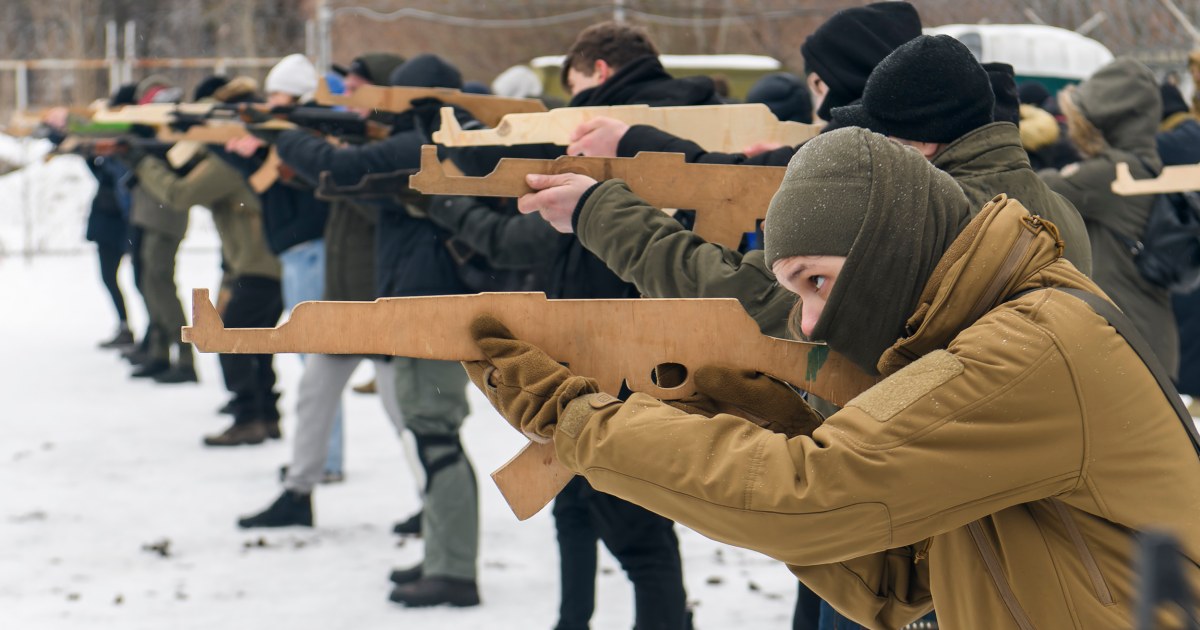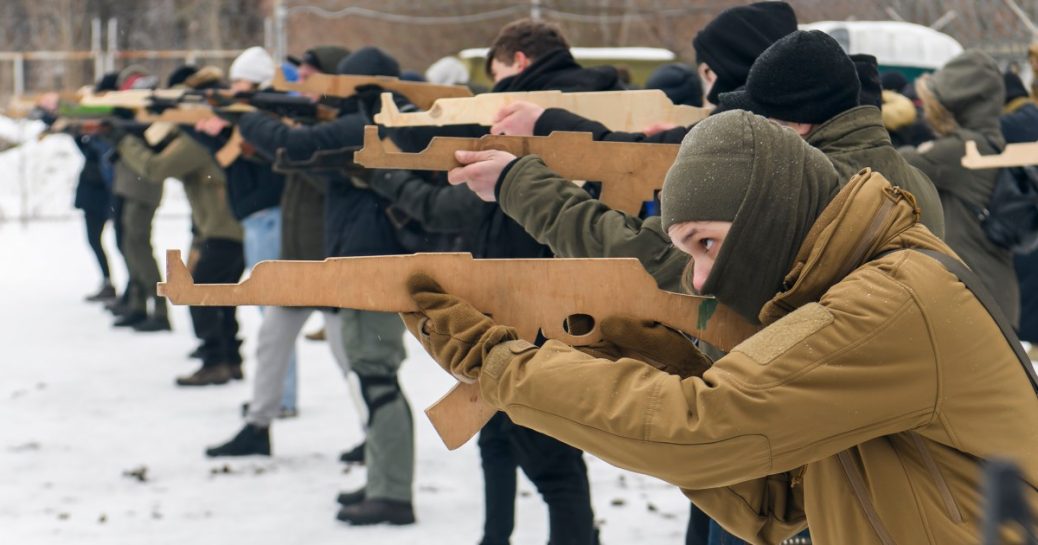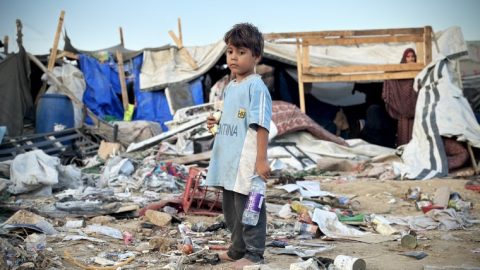
KHARKIV, Ukraine — On a recent frigid morning here in Ukraine’s second-largest city, Serhiy Pistonov, 54, and a group of middle-aged men were busy giving new meaning to the term “weekend warrior.”
Pistonov, the director of a cable systems firm, was instructing the men how to engage in what looked like a small-scale skirmish that ended in the detention of a pretend enemy fighter.
“All Ukrainians have spirit,” he said, when asked about the vastly superior military marshaling on the Russian side of the border. “Because you can have a lot of weapons. But if you don’t have spirit, you can’t do anything.”
Pistonov and his volunteer civilian ilk won’t be the country’s first line of defense against a Russian invasion, but they may very well be its last, according to Ukrainian and Western military analysts. They say a Russian invasion would quickly overwhelm Ukrainian forces in the early days of the fighting, almost immediately turning an open, conventional battle into an extended insurgency characterized by guerrilla-style harassment.
“Even with the disparity of forces, they can move in very fast and quite successfully, but then holding it would be a disaster,” said Andriy Zagorodnyuk, a former Ukrainian minister of defense who left office in 2020.
Zagorodnyuk said that Ukraine’s military is fully aware of its weaknesses when it comes to a conventional face-to-face war and that plans for an insurgency or guerrilla-style resistance movement led by Ukraine’s military are now the government’s primary strategy — even if the Ministry of Defense has not stated so publicly.
Ukraine’s Ministry of Defense declined requests for comment. On Sunday, Defense Minister Oleksiy Reznikov praised foreign governments for providing weapons and said Ukraine’s “military is already actively training with defensive weapons.”
But the statement perpetuated the Ukrainian government’s line that an invasion remains unlikely. “The probability of a significant escalation as of today continues to be assessed as low,” he said.
Ukrainian strategy is particularly crucial given an American intelligence assessment reported over the weekend. In addition to the more than 100,000 troops massed on its neighbor’s borders, Russia’s military has gathered heavy artillery, multiple rocket-launcher systems, hundreds of advanced fighter jets and amphibious ships in the Black Sea, a U.S. official with direct knowledge of the assessment told NBC News.
Ukraine’s military is simply no match for such sophisticated hardware. Ukraine’s capital, Kyiv, would likely fall within days, the official said, and 25,000 to 50,000 civilians would likely be killed or wounded in the first two weeks.
Despite fighting nearly eight years of war against Russian-led separatists in its eastern Donbass region, Ukraine’s military simply remains unprepared to take on the world’s second-largest military.
On a recent visit to the front lines near the village of Zolote in the country’s east, soldiers armed with AK-47s lounged in crudely dug trenches. There was little sign of the kind of high-tech weaponry needed to defend against a combined air and ground assault.
While Ukraine has invested a considerable amount of money and attention in its armed forces since Russia’s last invasion, in 2014, much of that went to its ground forces and navy, leaving its air defenses inadequate compared to Russia’s, said Alina Frolova, a former Ukrainian deputy minister of defense.
“We tried to make transformations over the last seven years, which is obviously not enough to renew capabilities that are the most expensive, like air defenses,” she said. “When you have 10 priorities on the table, some priorities are always going to be neglected.”
While the U.S. has contributed $2.5 billion in military aid to Ukraine since 2014, according to the Rand Corp., it has added very little to the country’s air force, which was seen as requiring too much time.
But unlike the high-tech resources needed to fight a modern military like Russia’s, Ukraine has already cultivated many of the ingredients needed to sustain an insurgency against a Russian occupation.
Zagorodnyuk was careful to say that while the fighting would be conducted guerrilla style, it would be led by regular army troops operating a campaign of harassment. He said he prefers the term “small group tactics” because “insurgency” implies that amateurs rather than professional soldiers would do most of the fighting.
Some of the most successful fighting against Russia-backed separatists in 2014 was led by volunteer units formed of Ukrainian and Soviet army veterans and activists that were later incorporated into Ukraine’s military.
The Azov Battalion, for example, played a crucial role in recapturing the southern city of Mariupol in 2014. But some of these groups can be problematic: Azov fighters were accused of torture and war crimes, and their ranks are populated by neo-Nazi sympathizers.
In addition to Ukraine’s more than 200,000-strong standing military, the country can mobilize some 300,000 soldiers, 130,000 of whom would form new territorial defense battalions.
A survey in December by the Kyiv International Institute of Sociology found that more than half of Ukrainians would fight in the event of a Russian invasion.
Yet, even as Russia’s colossal war machine musters around three sides of Ukraine’s borders, no mobilization of military reservists order has been given.
Even now, Ukraine’s official posture appears to be one of willful optimism. Calls for mobilization are seen as unnecessarily provocative toward the Russians and panic-inducing for Ukraine’s economy.
“No one seems to be in a hurry,” said Ukrainian military analyst Taras Chmut, the head of the largest military volunteer fund, Povernys Zhyvym. “We need to be more active and strengthen our army. It doesn’t matter whether Russia will attack or not.”
The insurgency or “small group strategy” has famously worked against far greater military might in the past. The Russian military retreated when faced with just such a campaign in Afghanistan in the 1980s, and more recently, the world watched Americans struggle against insurgencies in Iraq and Afghanistan.
But it’s still a big risk.
Such a strategy would rely on the passions and self-sacrifice of people like Pistonov, rather than the hard truths of superior technology and sheer military might.
“If the Russians start a war, it won’t be easy for them,” Pistonov, who insisted he was willing to die for Ukraine, said. “If the Russians do come in, I think we need to say them, ‘Welcome to the hell!’”









Recent Comments